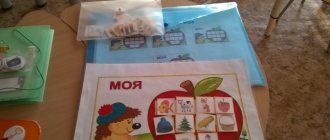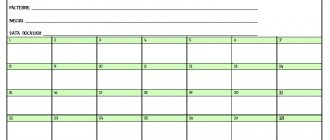Requirements for the activity corner in accordance with the Federal State Educational Standard for pre-school education consultation
REQUIREMENTS FOR THE CORNER OF ART ACTIVITIES IN ACCORDANCE WITH FSES DOO
Thematic zones in the group are a prerequisite for the harmonious all-round development of preschoolers. The richness of their content, together with suitable design, will allow children to gain a great experience during their stay in kindergarten. One of the favorite activities of both younger and older preschoolers is drawing, which contributes to the creative development of preschoolers. And the child will be able to find a suitable activity in the art corner, which the teacher will equip specifically for this purpose.
The purpose of the fine arts corner is to develop children’s creative potential, develop interest in artistic activities, develop aesthetic perception, imagination, artistic and creative abilities, independence, and activity.
Requirements for the creation and design of an art corner
According to the modern educational standard (FSES), the design of the fine art zone in a group must meet the following requirements.
- Compliance with sanitary and hygienic requirements. The corner is located in a well-lit place (near the window). Furniture must be appropriate for the height of children
- The equipment meets the needs of this age. After all, each age category is unique. For example, younger preschoolers are in the process of adaptation, so the teacher does not need to change the design often. Children's attention should not be distracted by unnecessary details. In addition, the art corner should contribute to the development of children's sensory skills. At an older age, conditions for self-expression are more important. Materials for creativity and aesthetic development (for example, picture albums) should be freely available to preschoolers so that they feel like “masters” in the group.
- High aesthetics. A good corner attracts children's attention with its beautiful design. The guys should feel comfortable there and experience aesthetic pleasure. “Children’s” design is important - the inclusion of game characters (pictures and dolls) and creative works of students in the design.
- Multifunctionality. The gaming environment can be modified depending on the learning situation and combined with other zones. After all, groups are not very large rooms, so every meter must be used rationally. Equipment and materials must be easily transformed to create a new game. For example, with the help of the Fine Arts corner, you can organize a role-playing game “In the artist’s workshop” (combined with the theatrical corner).
- Variability. The equipment of the zone changes periodically: new material for creativity is added, children's demonstration works and design elements are updated. In addition, conditions should be created in the corner for individual (for example, drawing, coloring pictures) and collective activities (looking at albums, didactic games).
- Safety and high quality of materials used in creating the zone. This applies to both furniture and means for directly equipping the corner (for example, dangerous items should be stored in boxes with a lid).
- Compliance with the gender principle. As you know, boys and girls have their own preferences. The teacher should take this point into account when selecting material in the art corner (in particular, offer coloring pages with cars, airplanes, robots and princesses, flowers, butterflies, etc.)
Contents of the ISO corner in the group
The most important component of the art zone in a group is its capacity.
First of all, these are directly materials for creativity, both traditional and non-traditional
- Paper of various textures and formats (A3, A4, A5).
- Paper tinted in warm and cool tones, two-color (blue top of the sheet is the sky and green is the grass).
- Colored pencils, wax crayons, felt-tip pens, gel pens, markers, charcoal, sanguine.
- Gouache and watercolor paints, brushes of different thicknesses, palettes, sippy cups, brush stands.
- Small magnetic drawing boards.
- Natural material for decorating designs (cones, acorns, seeds, sawdust, etc.).
- Devices and tools for drawing in non-traditional techniques (foam rubber, cotton swabs, toothbrushes, stamps, cocktail straws, etc.).
- Coloring books of various subjects, stencils depicting animals, plants, fruits, vegetables, cars, etc.
- Aprons and sleeves for preschoolers.
When filling the corner with materials, the age of the students must be taken into account.
So, at a younger age, colored pencils and felt-tip pens of primary colors are enough: black, red, yellow, blue and green. Further, the color range expands as children grow older. New materials are added as they are mastered (for example, watercolors, sanguine and charcoal in the older group). The same applies to materials for non-traditional art techniques (for example, after students in the junior group have mastered drawing with cotton swabs in class, the teacher places them in the art area).
Visual materials are also of great importance in the art corner. That is, in the corner there should be
- Reproductions of paintings by famous artists, demonstrating various genres (landscape, portrait, still life), portraits of painters.
- Albums on decorative and applied arts (“Gzhel”, “Khokhloma”, “Haze”, etc.). If a given topic was discussed in class, additional material on it is provided.
- Samples of toys and handicrafts. For children of primary preschool age - 2 - 3 types of folk toys (Bogorodsk toy, Semenov and other nesting dolls, Gorodets carved toy (horses), etc.). For children of middle and senior preschool age, 3 - 4 types of works of folk art are selected ( Dymkovo clay toy, works of Khokhloma and Gorodets masters, etc.).
- Folder with the best children's works.
- Album with works in non-traditional visual techniques.
- Collections of beautiful cards on various topics: New Year, Eighth of March, Victory Day, Cosmonautics Day. Children can use them as samples to create drawings and posters.
- Step-by-step diagrams for drawing popular objects (a person in different poses, a cat, a dog, a horse and other animals, birds, flowers).
- Posters on the topic of visual arts.
An integral part of the fine arts corner are didactic games of this type.
For younger preschoolers, these are simple guides to reinforce primary colors. The child’s task is to determine which colors are used in each specific drawing. Games like “Decorate Matryoshka’s sundress” are also suitable for kids: you need to match the sundress and flowers by color
In the middle group, games of the previous age become more complex and it is already possible to introduce games for the development of compositional skills and games in decorative and applied arts. At first they are simple, for example, “Place the candies in the vases.” Children must outwardly learn to distinguish products from different crafts from each other (match candies and vases)
In older preschool age, these games become more complex. For example, in arts and crafts games, the goal is to deepen knowledge. Children are invited to use cards to recreate the sequence of performing elements of folk painting. The manual may be aimed at a more detailed study of a specific painting, for example, Khokhloma. In addition, games are added to consolidate knowledge about painting genres; about perspective, horizon line, distance and approach of objects, foreground and background of the picture.
Another important component (although not obligatory) of the art corner in the group is a stand for children’s work. The child can hang his drawing there so that the teacher and other children can admire it.
An art corner organized in this way in a group will help preschoolers fully develop their artistic abilities, consolidate the material covered in class, and realize their own fantasies. The main thing is that materials and visual aids are always freely available. The bright and original design of this area is also important: after all, artistic taste needs to be developed from a very early age.
We decorate the corner in an original way with our own hands
An important part of organizing an art activity center is its aesthetic and original design. This is where the teacher can show all his imagination and passion for the profession. Modern furniture for kindergartens is often beautiful in itself and painted in colorful tones, but if the cabinet is quite simple, the teacher can transform it with a picture or a bright sticker, for example, a cheerful caterpillar whose body is painted in all the colors of the rainbow.
A colorful picture will transform even the simplest furniture
Alternatively, it could be funny multi-colored blots.
Funny blots on furniture will cheer up the kids
Often the wall near which the shelving is located is additionally decorated. We must remember that the picture should be positive, kind and carry a teaching load. This could be a cheerful forest animal, represented in the image of an artist, for example, a raccoon.
The forest animal is represented in the image of an artist
You can depict Pencil, the main character of the children's magazine “Funny Pictures,” who holds the artist’s tools in his hands.
The pencil is a symbol of the children's magazine “Funny Pictures”
You can stick on any popular character (Pinocchio, Dunno, Leopold the Cat), and he will hold children's drawings in his hands. One option could be a sun with pencil rays.
The wall will be enlivened by the sun made of colored pencils
The original decor is an image of a mysterious castle in which pencils live, and satin ribbons flutter on its spire.
An unusual idea - ribbons that flutter on the tower spire
The teacher can draw a picture on whatman paper and then cut it out or use ready-made vinyl stickers.
The image on the wall can be periodically updated, for example, in connection with the study of a particular topic.
A very original applique on the wall will attract children's attention to the study of folk crafts
An excellent decorative option is children's work using non-traditional techniques, decorated with an unusual frame.
Works should be placed in an original frame
If the fine art area is located near a window, then it can also be decorated thematically, for example, with voluminous multi-colored pencils with anthropomorphic features.
On the curtain (as well as on the wall) you can hang original three-dimensional pencils of different colors with a face, arms and legs
To make the art corner even more attractive to preschoolers, you can beautifully play with the creative material, for example, decorate stands for pencils and markers in an original way - in the form of a truck, a caterpillar. A stand for paper or folders with drawings can be imagined in the form of a cat with its tail raised up.
Fun decorative elements will lift children's spirits and increase their interest in creativity.
Photo gallery: examples of interesting design of art centers in a group
A very interesting wall design in the form of castles in yellow, green, red and blue colors, in which anthropomorphic pencils, paper and brushes live
An interesting design detail - silhouettes of trees with crowns of different colors
Bright details in the design of the corner - shapes of cheerful pencils with spring legs
The bright materials of the corner look beautiful against a blue background, and the cups covered with plastic spoons add originality.




